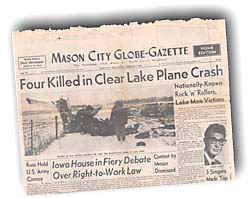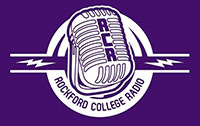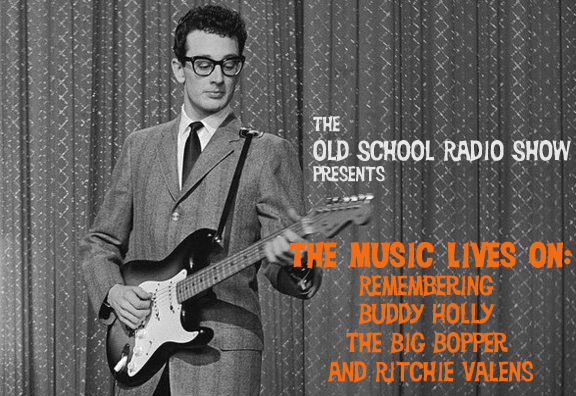
The Old School Radio Show presents a Buddy Holly tribute special: "The Music Lives On" on Rockford College Radio
“The Music Lives On”
This special program was conceived, researched, written and co-produced by Cece Forrester '72 and hosted by Ross Hunter '71 especially for the Old School Radio Show on Rockford College Radio. In this hour, which premiered on January 30, 2013, we presented some of Buddy Holly’s hits and a few rarities, some favorite cover versions both new and old, and a few special tribute songs. The show is now available as a podcast on Rockford College Radio and will be found by going to the Old School Radio Show page and clicking on the Podcasts button.
This page includes selected historical notes and commentary, links to key web sites and media extras. It also provides a track list (click the link) with song titles and artists, background information and links to purchase downloads of the music tracks.
 |
Buddy Holly’s life and career Buddy Holly, born Charles Hardin Holley, was only 22 years old when he died after a brief recording and performing career, but he was incredibly influential. Now recognized along with Chuck Berry and Elvis Presley as one of the pioneers of rock and roll as we know it, Buddy Holly established himself as a singer-songwriter and innovator in the studio, and helped popularize the two-guitars-bass-and-drums rock band. Holly’s music not only holds up well, but lends itself to creative arrangements right on down to the present, as new generations of artists discover and record their own cover versions of Buddy Holly’s songs—the hits he had with others’ compositions as well as those he wrote. Bio on Rock & Roll Hall of Fame site |
|---|
“The day the music died” In the early hours of February 3, 1959, a small chartered plane crashed near Mason City, Iowa, killing three musicians who had been traveling the upper Midwest with the “Winter Dance Party” tour. After playing the Surf Ballroom in Clear Lake, some of the performers wanted a break from the rigors of cold-weather bus travel and decided with a coin flip who would get seats on the plane. Besides Buddy Holly and the pilot, two others lost their lives— rising Latino rock star Richard Valenzuela, professionally known as Ritchie Valens, and radio disc jockey and recording artist J. P. Richardson, known as The Big Bopper. This event has become known in rock and roll history as “the day the music died.” Newspaper front page from 1959 (zoomable) and jump page |
|
|---|
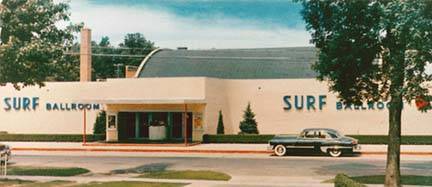 |
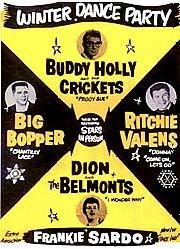 |
|---|
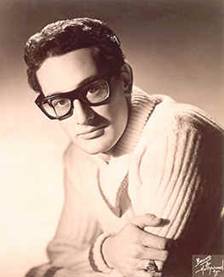 |
Did the music die? What “the day the music died” means is a matter of opinion, but starting in the late Fifties the pure rock sound fell out of fashion for a time as its early stars faded from the scene, rebellion turned to stagnation, the business changed, and a more commercial sound fronted by individual singers took over the American pop charts. Yet within a few years the sound Buddy Holly helped create was being reintroduced to America by the rock groups of the British Invasion, and regenerated again in the seventies by punk and new wave bands. Musical greats including the Beatles, the Rolling Stones, the Hollies, John Fogerty, Bruce Springsteen and Elvis Costello looked to Buddy Holly as an inspiration and role model. Even a seventeen-year-old Bob Dylan saw Holly perform in Duluth two nights before his death, and was profoundly impressed. Paul McCartney, a huge fan, owns the publishing rights to Buddy Holly’s songs. The power of the music was proven over and over with cover versions that became hits—even with younger fans who didn’t know who Buddy Holly was. We’ll never know what work Buddy Holly might have produced if he had been around longer. What we do know is that his influence is felt everywhere in popular music today, and that generations later his own songs are still heard and reinterpreted. The lives of musicians come and go, but the music lives on. A 2012 perspective on the evolution of rock & roll |
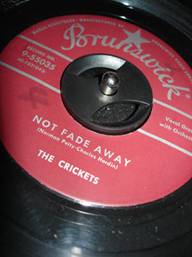 |
|---|
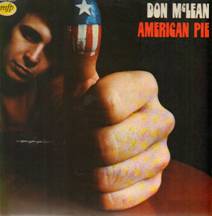 |
“American Pie”: what does it mean? Don McLean’s 1972 hit, “American Pie,” helped refresh our collective memory with an intriguingly symbolic storyline describing a decade of musical and cultural changes, beginning with memories of “the day the music died.” “American Pie” spent four weeks at number one in the US pop charts in 1972. One of the first, and some consider still the best, analysis of the meaning of the lyrics was done by Chicago disc jockey Bob Dearborn on WCFL-AM. Dearborn was working the late night shift at WCFL and many of his listeners had been calling and asking for insights or explanation of various metaphors in the then-chart rising song. After a week or so of this, he sat down at the typewriter at home, stereo playing excerpts of the song in the background, chronologically laying out the meaning of all the song's clever little metaphors into what became a five-page written analysis. This was way too long to be read in its entirety on a tightly formatted Top 40 station. So he mentioned on the air one Friday night what he had done, inviting anyone interested to send a letter and he would send thema copy. (Thanks to John Bace ’75 for sharing his platter patter.) A copy of what WCFL sent out and Bob Dearborn’s American Pie aircheck |
|---|
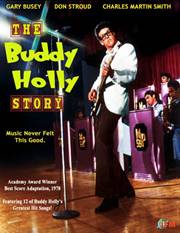 |
“The Buddy Holly Story”
|
|---|
 |
Contemporary tribute albums Two different groups of artists, spanning generations, contributed covers of Buddy Holly’s music to celebrate what would have been his 75 th birthday. Rave On Buddy Holly, or if that link isn’t working Just for fun Put Buddy Holly glasses on your own face
|
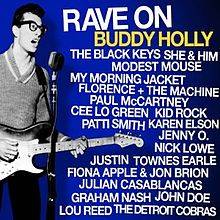 |
|---|
![]()


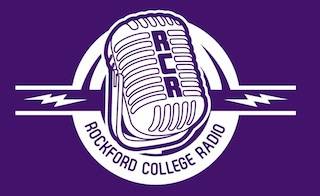
program notes and research by Cece Forrester
